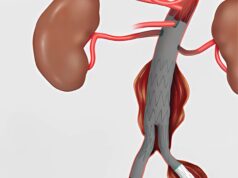In a new study from The Netherlands, published in the February 2009 issue of the Journal of Vascular Surgery, researchers have found that intermittent claudication can be reduced through community supervised exercise therapy programs in regional physiotherapeutic practices. Community programmes were found to be as just as effective as a hospital-based supervised exercise therapy, can be made available to more people, and save time and money for patients who do not wish to travel to a hospital two to three times per week for treatment.
Two hundred and seventy-two patients with intermittent claudication participated in the community-based exercise therapy study. The programme included inclined treadmill walking to near maximal pain for two to three 30-minute periods every week in the first three months. Sessions were reduced to once every two weeks at six months, and then to once every eight weeks at 12 months, depending on patient progress and preference. At the physiotherapist office, participants were encouraged to walk daily, to quit smoking, to lose weight (if necessary) and adapt a healthier lifestyle.
At one year, 129 patients were still in the program and absolute claudication walking distance increased significantly from a median of 400 metres at baseline to 1,100 metres. The distance corresponded to a median increase of 107.8 percent according to lead author Joep A W Teijink, Atrium Medical Centre, Heerlen, The Netherlands. Teijink noted that most of the increase in walking distance had occurred in the first six months of community based supervised exercise therapy, with no further improvement in the distance between six and 12 months of follow-up.
Secondary outcome measurements were functional claudication distance (the distance at which the patient would stop in daily life because of pain) and the number of invasive vascular interventions within one year after starting the community-based supervised exercise therapy. At one year, functional improvements rose from a baseline median of 230 metres to 700 metres, and only 16 percent of the initial 272 patients needed a invasive vascular intervention (e.g. angioplasty [Dotter procedure] or bypass surgery).
According to Teijink, one main concern in the community-based exercise therapy programme is the high dropout rate – 37% within six months and 53% within 12 months. However, the numbers were comparable with previous reports on clinic-based SET programmes, that were conducted as a part of randomised controlled trials instead of regular care as in this study. Of the 143 patients who discontinued community therapy in this study, 19 said it was due to satisfaction with the acquired walking distance, 26 claimed unsatisfying results, 22 were not motivated, 48 had a (non-vascular) intercurrent disease (e.g. cancer, arthrosis, cerebrovascular accident); and 28 gave other reasons.
“Supervised exercise therapy represents a viable treatment of intermittent claudication with no known complications, which cannot be said of invasive treatment options,” said Teijink. “It has the potential to treat patients safely, preventing an invasive vascular intervention. Even though many people discontinue supervised exercise therapy prematurely, its noninvasive nature and satisfactory improvement in the majority of patients are reasons to use it as the initial treatment.”
Researchers added that only after three months of community-based exercise therapy can a physician properly evaluate an individual’s response to the program and that one of the main reasons patients drop out of a community-based supervised exercise therapy is the intercurrent disease and not unsatisfactory results. “If a patient does drop out, the reason for their withdrawal from the program should be evaluated so their vascular surgeon can consider an invasive intervention if it is clinically indicated,” said Teijink.












